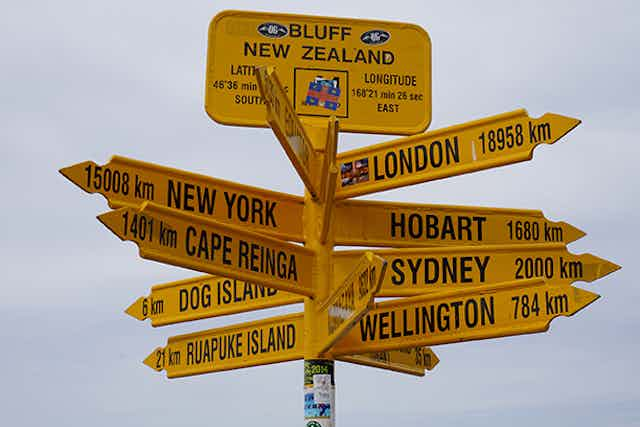Despite the US withdrawal from the 2015 Paris Agreement on climate change, other countries, including New Zealand, remain committed to cutting their greenhouse gas emissions.
In our report, we explore how New Zealand, a trailblazer for emissions trading, might drive a low-emission transformation, both at home and overseas.
Turning off the tap
Emitting greenhouse gases is a lot like overflowing a bathtub. Even a slow trickle will eventually flood the room.
The Paris Agreement gives all countries a common destination: net zero emissions during the second half of the century. It is also an acknowledgement that the world has only a short time to turn the tide on emissions and limit global temperature rise to below two degrees. The sooner we turn down the tap, the more time we have for developing solutions.

New Zealand’s 2030 commitment is to reduce emissions 30% below 2005 levels (11% below 1990). In 2015, our emissions (excluding forestry) were 24% above 1990 levels. The government projects a gap of 235 million tonnes between what has been pledged and what New Zealand will actually emit in the period from 2021 to 2030.
Reducing emissions rapidly enough within New Zealand to achieve our Paris commitment could be extremely expensive, and even at a cost of NZ$300 per tonne, the target could not be met through domestic action alone.
International emission reductions help bridge the gap. New Zealand could turn off its own greenhouse gas tap while supporting other countries to do the same.
Joining forces across borders
In the past, New Zealand relied heavily on the global Kyoto carbon market and purchased international emission reductions using the New Zealand Emissions Trading Scheme (ETS). Some ETS firms bought low-cost overseas Kyoto units of questionable integrity while domestic emissions continued to rise.
In 2015, New Zealand pulled out of the Kyoto carbon market and its ETS is now a domestic-only system.
Under the Paris Agreement, carbon markets have changed in three important ways:
Currently, international emission reductions can be traded only from government to government. It is no longer possible for NZ ETS participants to buy international units directly from the market.
International emission reductions sold as offsets to other countries will have to be additional to the seller’s own Paris target.
Countries have flexibility to trade international emission reductions through arrangements outside of the central UN mechanism which is at an early stage of development.
A new approach to reducing emissions
What does this mean for New Zealand? First, we cannot and must not rely on international markets to set our future domestic emission price.
Second, as both taxpayers and responsible global citizens, we need to decide where to fund emission reductions. Most mitigation opportunities are in developing countries. The benefits of investing in lower-cost reductions overseas need to be weighed against the costs of deferring strategic investment in New Zealand’s own low-emission transformation.
Third, we need an effective mechanism to direct New Zealand’s contribution to mitigation overseas.
In collaboration with others, Motu researchers are prototyping a new approach: a results-based agreement between buyer and seller governments within a climate team.
For example, New Zealand could partner with other buyers – such as Australia, South Korea or Norway – to pool funding at a scale that provides incentives for a country with a developing or emerging economy – such as Colombia or Chile – to invest in low-emission transformation beyond its Paris target. These countries could then create a more favourable environment for low-emission investment – including by New Zealand companies.

Retooling the ETS for domestic decarbonisation
So far, New Zealand has been moving at speed but in the wrong direction, relying heavily on international emission reductions to meet its targets from 2008 through 2020 while domestic emissions continued to rise. Gross emissions (excluding forestry) are projected to climb 29% above 1990 gross emission levels by 2030 under current measures. This is a far cry from our 2030 Paris target of net emissions of 30% below 2005 gross emission levels (11% below 1990).
New Zealand’s ETS has an important role to play in achieving a successful low-emission domestic economy, but it needs to be properly equipped.
Unlike other financial markets, the purpose of an ETS market is more than price discovery, resource allocation and liquidity. It is designed to create a change in behaviour to reduce emissions. Prices are driven not just by the interplay of demand and supply, but by current policy decisions, emission reduction opportunities, and expectations about future decisions and opportunities.
Since de-linking from the Kyoto market in mid-2015, NZ ETS participants have had no certainty on how to invest. They need clear near-term signals for unit supply and cost and predictable processes for longer-term decision making.
Five changes to make the emissions trading work
Introducing a cap (fixed limit) on NZ ETS units sold or freely allocated by the government will define supply and enable the market to set an efficient price. In the past, the NZ ETS borrowed the global Kyoto cap, which essentially allowed unlimited domestic supply. The Kyoto cap is no longer available and we have committed to reducing domestic emissions.
Establishing a price band will provide a minimum and maximum emission price limit, set by government. A price floor will guarantee a minimum return on low-emission investment and a price ceiling will safeguard against upside price shocks. When the floor and ceiling are far apart, the market has latitude when setting the price. The closer they are, the more the government manages the price. The price band will be implemented at auction and replace the current fixed-price option set at NZ$25 per tonne.
Fixing both the cap and the price band for five years and extending them by one year each year will provide short-term certainty. The government will also need to set indicative trajectories for caps and price bands for a further 10 years in alignment with its decarbonisation objectives. This will enable long-term decision-making.
Given the technical complexity of the ETS, we recommend that an independent body be tasked with advising government on ETS supply and price settings. Ultimately however, decisions on caps and price bands are political and therefore should be taken by government, with transparency and public accountability.
The era of top-down carbon markets, unlimited unit supply and rising domestic emissions has ended. Right now, only governments can purchase international emissions reductions. In the longer term, ETS participants may also be able to do so. However, the quantity must be limited and displace other supply under the cap to avoid devaluing domestic investment and disrupting New Zealand’s progress toward decarbonisation. All international emission reductions applied toward New Zealand’s targets must be quality assured to manage risks with environmental integrity.
These adjustments can be achieved through practical legislative amendments and regulation. There is merit in implementing these changes as soon as possible so that low-emission investors and emitters can get on the road.
Setting the ambition of domestic ETS caps and price bands can be politically challenging. That is why New Zealand skipped this step the first time around and borrowed the Kyoto ones instead. Under the Paris Agreement, New Zealand needs to establish a resilient policy architecture with cross-party support that offers predictable processes to guide future political decision making. It’s time for us to forge our own pathway to a successful low-emission economy.
This article was prepared by Suzi Kerr, Catherine Leining and Ceridwyn Roberts at Motu Economic and Public Policy Research. The supporting paper was funded by the Aotearoa Foundation and informed by participants in Motu’s ETS Dialogue. The content does not necessarily represent the views of or endorsement by ETS Dialogue participants, their organisation or the funder.

